
Operation: 'Exodus'
Date: 9th May 1945 (Wednesday)
Unit No: 514 Squadron
Type: Lancaster III
Serial: RF230
Code: JI:B
Base: RAF Waterbeach - via Juvincourt, France
Location: South East Roye, France
Pilot: Fg Off. Donald Beaton DSO. 179980 RAFVR Age 22. Killed
Flt Eng: Flt Sgt. Alfred McMurrugh 939832 RAFVR Age 23. Killed
Nav: Fg Off. Ray Bertram Hilchey J40778 RCAF Age 22. Killed
WOp/Air Gnr: Flt Sgt. John Goodworth Brittain 1892880 RAFVR Age 20. Killed
Air Gnr (Mid Upp): Flt Sgt. Orval Clare Evers R279032 RCAF Age 19. Killed
Air Gnr (Rear):Sgt. Robert MacPherson Toms R271567 RCAF Age 20. Killed
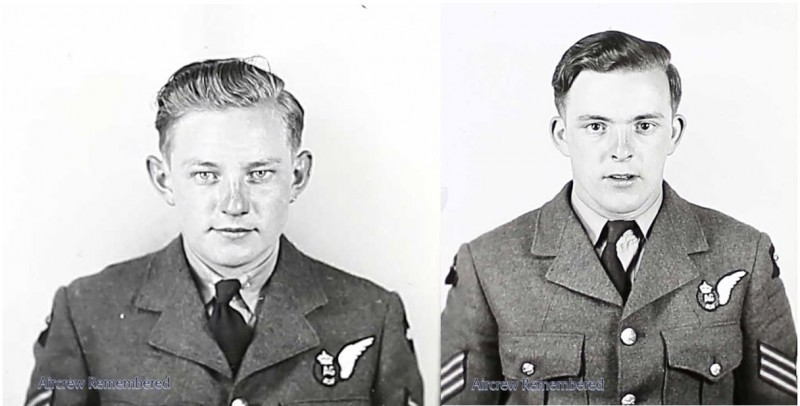
Above left: Flt Sgt. Evers and right: Sgt. Toms - both photographs from their Service records.
REASON FOR LOSS:
During May following the declaration that the war in Europe was over the RAF were ordered to carry out 'Operation Exodus' the repatriation of ex PoW's being released from the various camps.
Taking off from the airfield at Juvincourt at around 12:15 hrs with the recommended maximum of 24 passengers. Very shortly after at 12:26 hrs having covered some 43 nautical miles the Lancaster came down in a wooded area killing all the crew and passengers.
The aircraft was seen to circle the airfield twice without losing height and with all four engine running. The undercarriage was lowered on the first circuit and Red Verey lights were fired from the aircraft. The undercarriage was then raised. Permission to land was given for the airfield but no reply was received. Green Verey lights were then fired to indicate the pilot had permission to land. The wind was light and variable with the control vehicle on the port side of the runway.

The undercarriage was then seen to be lowered again and the aircraft headed South East from the airfield flying slowly. It was then seen to go into a vertical bank to port with the nose up. The Lancaster then went into a flat spiral levelling out just above some trees. It then dropped in a very flat attitude to the ground and caught fire.
The subsequent court of enquiry held on the 20th May 1945 found that 12 bodies were recovered from the rear of the aircraft and it is assumed that the passengers had moved to the rear of the aircraft whilst still in flight and that the pilot must have realised that the aircraft was dangerously tail heavy, it is assumed he had decided to make a forced landing.
The cause of the accident was due to the incorrect position of passengers possibly due to them moving to the rear of the aircraft when they realised something was wrong. However no reason can be given as to why the pilot had prior to this, decided on a forced landing. The aircraft was on track and the pilot had sufficient control to enable him to fly round the airfield with the undercarriage down indicating his intention to land.
Future flights of this type then introduced much stricter briefings with regard to passenger distribution.

Above: Court of enquiry reports (courtesy John Jones)
Burial Details:

Crew:
Fg Off. Donald Beaton DSO. Clichy Northern Cemetery. Plot 16. Row 12. Collective grave 7-18. Inscription: 'DILEAS GU BAS' (Faith unto Death). Son of John and Margaret Beaton, of Glasgow, Scotland.
Fg Off was and experienced pilot with 668 flying hours logged.
Fg Off. Beaton was awarded the DSO whilst with 514 Sqn. London Gazette 3rd November 1944. Citation: "As pilot and captain of aircraft Flying Officer Beaton has completed many operational sorties against a variety of targets in Germany and occupied territory. In September, 1944, he took part in a daylight attack on Le Havre. Whilst over the target the aircraft sustained severe damage when struck by anti-aircraft fire and temporarily went out of control. Flying Officer Beaton was badly wounded, suffering a broken leg and multiple wounds caused by flying fragments of shell. Although in great pain he regained control and set course for home. Making light of his injuries he refused to leave the controls and flew back to an airfield near the coast where he landed his damaged aircraft safely. This officer displayed outstanding courage and fortitude. Though severely wounded he never wavered in his determination to bring his aircraft and its crew home. His example was most inspiring."
He is also remembered in the Roll Of Honour at the Scottish National War Memorial.
Flt Sgt. Alfred McMurrugh. Clichy Northern Cemetery. Plot 16. Row 11. Grave 18. Inscription: 'TREASURED MEMORIES OF ALFRED, DEARLY BELOVED HUSBAND OF IRENE'. Son of Jack and Kate Elisa McMurrugh; husband of Irene Lilian McMurrugh, of Harborne, Birmingham.
Fg Off. Ray Bertram Hilchey. Clichy Northern Cemetery. Plot 16. Row 12. Collective grave 7-18. Inscription: 'HE GAVE HIS LIFE FOR OTHERS'. Born on the 16th February 1923 in Popes Harbour, Halifax, Nova Scotia. Son of Stanley Bertram and Lauretta Esperance (née Lawlor) Hilchey of Halifax, Nova Scotia.
Flt Sgt. John Goodworth Brittain. Clichy Northern Cemetery. Plot 16. Row 12. Grave 6. Inscription: 'SACRED TO THE MEMORY OF OUR ONLY SON'. Son of John Goodworth Brittain and Ethel Maud Brittain, of Cricklewood, Middlesex, England.
Plt Off. Orval Clare Evers. Clichy Northern Cemetery. Plot 16. Row 12. Collective grave 7-18. Inscription: 'WE CANNOT, LORD, THY PURPOSE SEE BUT ALL IS WELL THAT'S DONE BY THEE'. Born on the 8th September 1925 in Kitchener, Ontario. Son of Charles Neil and Susan (née Caesar) Evers of Sarnia, Ontario, Canada.
He was granted a commission and promoted to J95536 Plt Off. on the 8th May 1945 and appointed the Sqn Gunnery officer.
Plt Off. Robert MacPherson Toms. Clichy Northern Cemetery. Plot 16. Row 11. Grave 19. Inscription: 'WHO DIED THE NOBLEST DEATH MEN MAY DIE, FIGHTING FOR GOD AND LIBERTY. Born on the 6th May 1925 in Grand Falls, Newfoundland. Son of Edward and Effie May (née MacPherson) Toms of Grand Falls, Newfoundland.
He was granted a commission and promoted to J95531 Plt Off. on the 8th May 1945
Passengers - Return PoWs:
1st Lt. Judah Harry Lewittes O-700745. Air Medal (9 Oak Leaf Clusters) Epinal American Cemetery, Plot A, Row 16, Grave 64. Born on the 2nd December 1921 in the Bronx, New York. Son of Max and Dora H. (née Weberman) Lewittes of Fishkill, New York. Husband to Notburga 'Rose' (née Bachmann) Lewittes of Dutchess, New York, USA.
It is known that he was originally aboard a B-26 from 497th Bombardment Squadron (M), 344th Bombardment Group (M) before becoming a PoW. There is no record of the aircraft details (other than it was a B-26), its loss, the identity of other crew members or their fates.
Note: a B-26G #43-34293, K9:O from the 344 BG, was reported to have landed at an Advanced Landing Strip on the 26th September 1944 with no further details known. As all other losses from the 344 BG have been accounted it is possible that this was his aircraft.

Above left: 1st Lt. Lewittes from Ancestry.co.uk and right grave marker (Courtesy of Dwight "Andy" Anderson)
Sgt. Ronald Arthur Adams. Age 26. 5111739 7th Bn. Royal Warwickshire Regiment. Clichy Northern Cemetery Plot 16. Row 12. Grave 1. Inscription: 'REST ETERNAL GRANT UNTO HIM, O LORD'. Son of Albert and Ellen Louise Adams, of Coventry, England.
Pte. Thomas Anderson. Age 22. 2940187 2nd Bn. Queen's Own Cameron Highlanders. Clichy Northern Cemetery Plot 16. Row 11. Grave 15. Inscription: ‘ON WHOSE SOUL, SWEET JESUS, HAVE MERCY; OUR LADY OF LOURDES, PRAY FOR MY SON’. Son of John and Mary Anderson, of Glasgow, Scotland.
Pte. William Leonard Ball. Age 31. 804169 1st Bn. The Queen's Royal Regiment (West Surrey) Attached to Pioneer Corps. Clichy Northern Cemetery Plot 16. Row 11. Grave 16. Inscription: 'IN LOVING MEMORY OF OUR DEAR BILL. ALWAYS IN THE THOUGHTS OF ALL HIS FAMILY'. Son of George Henry and Amelia Harriett Ball, of Ashford Common, Middlesex, England.
Pte. Samuel James Bayston. Age 29. 4751822 4th Bn. Green Howards (Yorkshire Regiment). Clichy Northern Cemetery. Plot 16. Row 12. Collective grave 7-18. Inscription: ‘SWEET IS THE SPOT WHERE YOU ARE LAID, OUR MEMORIES OF YOU WILL NEVER FADE’. Son of George and Elizabeth Sophia Bayston, of Kennington, London, England.
Cpl. Emanuel L. Belshaw. Age 40. 2650397 2/6th Bn. East Surrey Regiment. Clichy Northern Cemetery. Plot 16. Row 12. Collective grave 7-18. Inscription: 'WHEN SLEEP FORSAKES OUR EYES OUR THOUGHTS GO TO A GRAVE WHERE OUR DEAR ONE LIES'. Son of Emanuel and Jane Belshaw and Husband of Elsie May Belshaw, of Addlestone, Weybridge, Surrey, England.
Pte. Roland Albert Betton. Age 26. 4032985 1st Bn. King's Shropshire Light Infantry. Clichy Northern Cemetery Plot 16. Row 12. Grave 3. Inscription: 'IN MEMORY OF A BELOVED HUSBAND AND DEAR SON. NEVER TO BE FORGOTTEN. R.I.P.'. Son of Albert and Harriet Betton and Husband of Dorothy Mabel Betton, of Pontesbury, Shropshire, England.
Lt. Patrick Archibald Tomlin W.B. Campbell. Age 36. 124175 6th Bn. Queen's Own Royal West Kent Regiment. Clichy Northern Cemetery Plot 16. Row 12. Grave 2. Inscription: 'OUR LOVE WILL FOLLOW YOU STILL’. Son of Mr. and Mrs. William Betts Campbell.
Pte. Ronald Ernest Clark. Age 29. 5954856 2nd Bn. Royal Scots. Clichy Northern Cemetery Plot 16. Row 11. Grave 14. Inscription: 'LOVING MEMORIES OF A DEAR HUSBAND AND FATHER ARE DEEP IN OUR HEARTS. WIFE & DAUGHTER'. Son of Ernest and Amelia Clark, of Luton, Bedfordshire and Husband of Edith May Clark, of Luton, England.
Pte. Walter Croston. Age 32. 2185985 Pioneer Corps. Clichy Northern Cemetery Plot 16. Row 12. Grave 5. Born on the 14th January 1913 in Salford Lancashire. Son of Richard KiA 23rd April 1917 in France) and Sarah H. (née Thompson) Croston of Barton, Lancashire, England.
Gnr. Alfred James Spencer Crowe. Age 26. 840450 28 Field Regt. Royal Artillery. Clichy Northern Cemetery Plot 16. Row 11. Grave 9. Inscription: ‘R.I.P’. Son Of Alfred Edward Charles And Margaret Crowe.
Fus. Harold Cummings. Age 22. 3461448 2nd Bn. Lancashire Fusiliers. Clichy Northern Cemetery Plot 16. Row 11. Grave 11. Inscription: 'TIME GOES ON, YEARS ROLL BY, THOUGHTS OF YOU WILL NEVER DIE'. Son of Frederick and Lizzie Cummings, of Salford. Lancashire, England.
Pte. Richard Danson. Age 32. 3392078 16th Bn. East Surrey Regiment. Clichy Northern Cemetery. Plot 16. Row 12. Collective grave 7-18. Inscription: ‘INTO THY HANDS, OH LORD'. Son of John and Lena May Danson and Husband of Grace Danson, of Kirkham, Lancashire, England.
Rfl. Thomas James Edwards. Age 32. 6912680 1st Bn. Rifle Brigade. Clichy Northern Cemetery. Plot 16. Row 12. Collective grave 7-18. Inscription: 'TO THE WORLD HE WAS ONLY ONE, TO ME HE WAS ALL THE WORLD'. Son of Thomas James Edwards and Sarah Edwards and Husband of Maud Edwards, of Wanstead, Essex, England.
L/Cpl. George William Franks. Age 32. 6844798 2nd Bn. King's Royal Rifle Corps. Clichy Northern Cemetery Plot 16. Row 11. Grave 13. Inscription: 'YOU WILL SPEED US ONWARD WITH A CHEER, AND WAVE BEYOND THE STARS THAT ALL IS WELL'. Son of James Edward and Agnes Ellen Franks, of Westminster, London, England.
Gnr. A.N. Labotske. Age? 45537 4 Field Regt. South African Artillery. Clichy Northern Cemetery. Plot 16. Row 12. Collective grave 7-18. No further details - are you able to assist?
Pnr. W.L. Lindheimer Age 30. Pal/12055 Pioneer Corps. Clichy Northern Cemetery Plot 16. Row 12. Grave 4. Born on the 2nd December 1914 in Germany . Son of Eli and Babette (née Israel) Lindheimer of Philadelphia, Pennsylvania, USA.
Pnr. Mordhai Maschit. Age? Pal/12056 Pioneer Corps. Clichy Northern Cemetery. Plot 16. Row 12. Collective grave 7-18. No further details - are you able to assist?
Fus. Owen Parkin. Age 25. 3448706 1/8th Bn. Lancashire Fusiliers. Clichy Northern Cemetery. Plot 16. Row 12. Collective grave 7-18. Inscription: 'GOD'S GARDEN MUST BE BEAUTIFUL HE ONLY TAKES THE BEST. REUNITED WITH MAM'. Son of Mr. and Mrs. James Parkin, of Lower Broughton, Salford, Lancashire, England.
Gdsm. James Arthur Roe. Age 25. 2719806 1st Bn. Irish Guards. Clichy Northern Cemetery Plot 16. Row 11. Grave 10. Inscription: 'A CORNER IN OUR HEARTS IS SET ASIDE FOR YOU; NOT JUST TO-DAY BUT EVERY DAY'. Son of John and Elizebeth Roe, of Edgbaston, Birmingham, England.
Lt. Eric Thomas Theodore Snowdon. Age 27. 94190 53 A.A. Regt. Royal Artillery. Clichy Northern Cemetery Plot 16. Row 11. Grave 8. Inscription: 'MANY A LONELY HEARTACHE BUT ALWAYS A BEAUTIFUL MEMORY OF ONE WE LOVED SO DEAR'. Son of John H. R. Snowdon and Marie Snowdon, of Ealing, Middlesex, England.
Cpl. Albert George Thompson. Age 25. 5253245 7th Bn. Worcestershire Regiment. Clichy Northern Cemetery Plot 16. Row 11. Grave 12. Inscription: 'AT THE GOING DOWN OF THE SUN AND IN THE MORNING WE WILL REMEMBER HIM'. Son of Albert Edward and Lizzie May Thompson, of St. Johns, Worcester, England.
Pte. Ralph Turnbull. Age 28. 4451208 1st Bn. Durham Light Infantry. Clichy Northern Cemetery. Plot 16. Row 12. Collective grave 7-18. Inscription: 'OVER THE RIVER, FACES I SEE; DEAR ONES IN GLORY ARE WAITING FOR ME'. Son of Albert Victor and Elizabeth Mary Turnbull, of Gateshead, Co. Durham, England.
Capt. Robert Worsley Wheeler. Age 26. 85759 Royal Engineers. Clichy Northern Cemetery Plot 16. Row 11. Grave 17. Inscription: ‘NOT IN MONUMENTS ALONE BUT IN THE HEARTS OF ALL, THEIR MEMORY ABIDES. Son of Herbert Edward Ogle Wheeler and Edith Catharine Wheeler, of Storrington, Sussex, England.
Pte. Patrick Yates. Age 23. 14208422 2/5th Bn. Leicestershire Regiment. Clichy Northern Cemetery. Plot 16. Row 12. Collective grave 7-18. Son Of Henry Claude And Sarah Jessie Yates.
Researched by Kelvin Youngs (Webmaster) and dedicated to the relatives of this crew with thanks to John Jones who supplied us with the Court of enquiry papers (Sep 2018). Thanks Raf Dyckmans for the confirmation of 1st Lt. Lewitte being aboard this flight. Reviewed and updated with further information relating to 1st Lt. Lewitte who was originally rumoured to be aboard the Lancaster which has now been confirmed. (Jan 2023).
Other sources listed below:
No. 514 Squadron Loss: RF230, F/L Beaton and Crew
Addendum: Court of Inquiry and Beyond
Court of Enquiry Download here Courtesy of Ralph Snape.
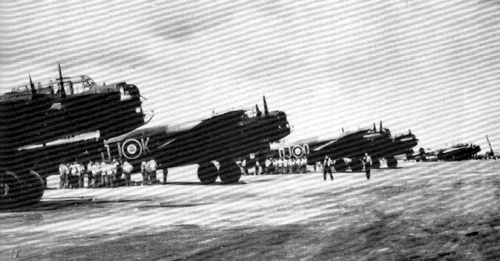
Above: Lancasters of 149 Squadron, lined up at Juvincourt in May 1945 during Operation Exodus, POW repatriation. Courtesy of Avro Lancaster- The Definitive Record by Harry Homes.

Above: Operation Exodus: Crew and POW Passengers before boarding Lancaster ME455, LS-O, of 15 Squadron at Juvincourt. Courtesy of Avro Lancaster- The Definitive Record by Harry Homes.
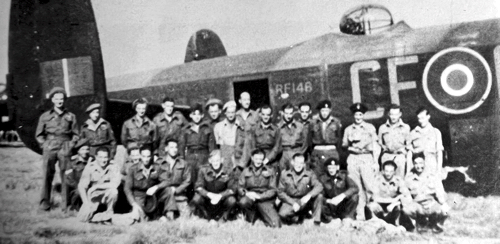
Above: Operation Exodus: Crew and 24 POW Passengers with 625 Squadron Lancaster RF146, CF-G2, W/O H.E. Benson and crew on May 26, 1945, Brussels to Dunsfold. Courtesy of Lancaster in Action by squadron/signal publications.
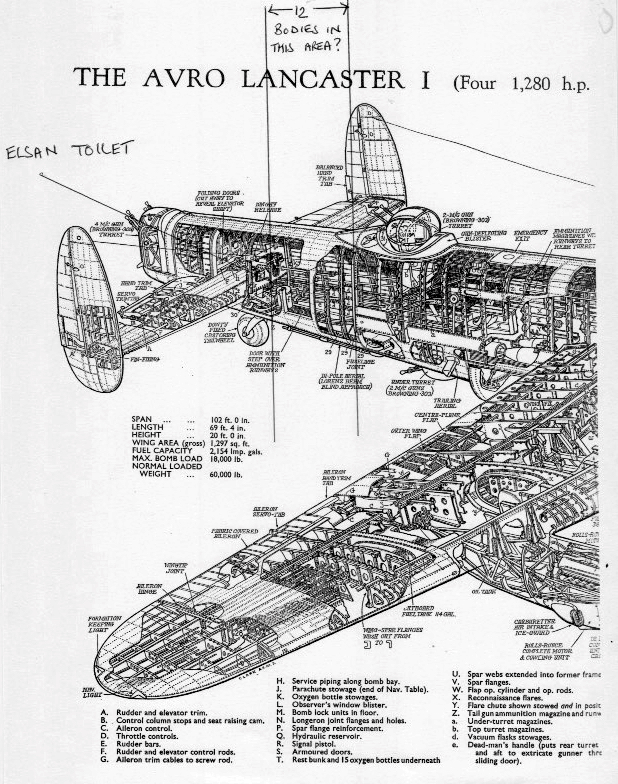
Above: Diagram of the aft section of a Lancaster pointing out the location of twelve bodies described in the Court of Inquiry text, adjacent to the rear door. Courtesy of Avro Lancaster- The Definitive Record by Harry Homes.
The archive report on the loss of this aircraft, crew and passengers, attributes the cause to loss of control, resulting from passengers moving to the rear of the aircraft, with an aft shift of the centre of gravity (C of G) beyond the approved limits.
Pilot training includes the theory of flight, navigation, airmanship and meteorology. Included is an introduction to invisible dangers that knowledge and prevention are essential to ones survival. These include such factors as spatial disorientation, hypoxia, density altitude, icing, freezing rain, thunderstorms, and weight and balance deviations. The latter factor is reviewed and examined with each proficiency test to emphasize its importance.
To exceed the gross takeoff weight or operate outside the centre of gravity envelope exposes the aircraft to structural failure in turbulence or loss of control that may not be recoverable. With a C of G forward of limits, the pilot may not have sufficient elevator control to rotate for takeoff and run off the end of the runway.
However, a C of G aft of limits is much a spookier variant. As the airspeed deceases below the stall speed, the aircraft will stall and enter an unrecoverable flat spin, as the elevators do not have sufficient airflow to lower the nose, regain airspeed and recover from the stall.
The aft C of G scenario may be set up prior to takeoff with improper loading of baggage, passengers or fuel. Over four decades the author can recollect two accidents that occurred due to improper loading with an aft C of G:
A Beech-18 overloaded with a group of American tourists, their fish catch stored in the rear baggage compartment, stalled on takeoff at 300 ft AGL. There were no survivors. The commercial pilot was the owner/operator of the company.
The second occurred at our local airport on July 1st, Canada Day. On returning from a local flight I was advised to use an alternate runway as the one I had departed on was closed. On crosswind I observed a crumpled Cessna 172 halfway down the runway, surrounded by several ambulances. From a fellow instructor I soon learned the details of this accident. A brand new private pilot had invited three of his friends along for a flight. The aircraft was fully fuelled and he loaded his two heaviest passengers into the rear seats. Overweight and aft C of G. On the takeoff the nose pitched up to 300 ft AGL, the aircraft stalled and crashed beside the runway. There was no fire! The pilot was seriously injured, his passengers died on impact or before the ambulances arrived. I will never forget the drive home. As I left the airport an ambulance pulled in front of me, no sirens or flashing lights. The message was clear and sobering.
The other variant of aft C of G is the sneakier one, as the aircraft may depart with the C of G within limits but shifts due to rearward movement of baggage, passengers, fuel or even water.
Two examples come to mind:
A single engine Cessna floatplane departed from a local waterway. On the climb out the aircraft pitched up, stalled and crashed. The pilot did not survive. Accident investigators identified the cause to be water in a leaky float flooding to the rear on the climb out, shifting the C of G beyond limits and controllability. The pilot in his pre-flight inspection had neglected to pump his floats dry.
The second example of aft shifting C of G is pertinent to the loss of Lancaster RF230. A Washington State Beech-18 was participating in a mass simultaneous parachute jump. The pilot had climbed the fully loaded aircraft to 12,000 ft AGL. As the parachutists moved to the rear exit the nose pitched up and the aircraft stalled. Two of the jumpers managed to exit via the rear door before the aircraft entered an unrecoverable flat spin. Of those remaining on board, no one survived.
This scenario is almost identical to the factors at play with the loss of RF230, her crew and passengers. When control was lost RF230 was at circuit altitude, approximately 1,000 ft AGL, with undercarriage and flaps extended, with elevator trim full nose-down, and engines idling. Almost as if the pilot had surrendered to his fate.
Shortly after takeoff F/L Beaton and his crew of six in total (no bomb aimer for obvious reasons) were confronted with an inflight emergency that necessitated an immediate landing, no time to return to Juvincourt and for some reason, no means of communicating their situation.
From a pilot’s perspective several possibilities come to mind: inflight fire, impending fuel starvation or aircrew incapacitation. We know from the loss of 625 Squadron’s LL956 that an engine fire can bring down an aircraft six minutes after takeoff.
https://aircrewremembered.com/hannah-lloyd-albert....
“Smoke in the cockpit” is a situation that all pilot’s dread. What is the source? Can we put it out? How quickly can we be on the ground? Anxiety levels increase exponentially until there is resolution. Swiss Air Flight 111, September 2, 1998 comes to mind.
https://en.wikipedia.org/wiki/Swissair_Flight_111
Philip Gray in his book, Ghosts of Targets Past, provides a vivid example of how distressing this can be for an operational Lanc crew. On the outbound leg to Kiel the crew was alerted by smoke in the cockpit. After a frenzied search the culprit was found to be one of the radios, a Type 52 Resistance unit was on fire. It took two fire extinguishers to subdue the flames and the unit was “turned off for good”. This would mean no more contact with base.
It does not take much to imagine the impact that a similar distraction would have on RF230’s flight crew shortly after takeoff during the climb out. The crew was trained to deal with such an emergency. However, the passengers with the exception of one, 1st Lt. Judah Lewittes, were non-aviators and reacted as expected, confronted with a fire in the forward section of the aircraft—they moved as far aft as possible and congregated near the starboard exit door. Before F/L Beaton or his crew could react the airspeed had dropped below that needed to recover. Behind the power curve and realizing that their situation was futile, he retarded the throttles—possibly as an indicator he understood he had done everything in his power to save his crew, passengers and aircraft. In effect he was no longer the pilot in control, merely a passenger.
One other finding at the time of the investigation was a passenger’s boot jamming the rudder control rod. This would have affected the pilot’s ability to control yaw and maintain directional control. In effect he had lost attitude and directional control at a dangerously low airspeed, and altitude.
John Naylor makes the following observation: They would also have been compromised if for some reason, the Lanc had to ditch in the sea. Normal dinghy drills would have been useless, owing to non-capacity! Escape routes would have been clogged and the poor crew left helpless!
The other emergency situations are easy to exclude. Fuel starvation is most unlikely as the aircraft was in the early phase of the flight and there was a significant post-crash fire. Medical incapacitation was a possibility but also unlikely due to the pilot’s youthfulness. Conditions such as cerebral hemorrhage from berry aneurism, gastrointestinal hemorrhage from an ulcer and pulmonary embolism (lung clots) could all occur at this age. The fact that the throttles were retarded before impact indicates the pilot was in control of his faculties. It is unlikely the flight engineer would have taken this action.
One other issue resulting from the findings of this Court of Inquiry needs to be addressed. The cause of this accident is placed squarely on the shoulders of the nineteen-year-old, Canadian, Mid-Upper Gunner, F/Sgt Orval Evers:
Remarks by Base Commander- It must, however be agreed that the responsibility appears to lie with the Mid-Upper Gunner whose duty it was to ensure that the passengers remained in their allotted positions when approaching to land.
(sigd) ?
W/Commander
No. 33 Base, RAF
Remarks by Group Commander- 6. The briefing of the crew was satisfactory and the responsibility for disregarding the loading instructions must be placed on the Mid Upper Gunner or the passengers themselves.
(sigd) R. Harrison
Air Vice-Marshal
Commander No. 3 Group.
It is unconscionable that this young Air Gunner could be found responsible for the lives of his five crew mates and twenty-five passengers. By the time he realized that there was a dangerous situation developing it would have been impossible for him to instruct the panicked passengers to return to their designated positions. One has to keep in mind that he was trained as a gunner and he would have had little knowledge of the importance of C of G limits. This was the pilot’s responsibility. This scapegoating of F/Sgt Evers by a senior RAF officer as the cause of this accident could be perceived, by those not familiar with certain wartime anomalies, as an example of colonial discrimination.
https://aircrewremembered.com/manning-ralph-viril....
However, the role of the Lancaster was as a heavy bomber, not a passenger transport. The fact it had been forced into the latter role shows poor insight by the RAF administration. If the POW passengers had no safety restraints (seat belts) in the event of turbulence or a forced landing in the event of an emergency, the pilot would be confronted with the risk of an aft shift in the C of G at a most inopportune time—resulting in loss of control with no chance of recovery. If the passengers had been adequately restrained F/L Beaton would have been able to carry out an emergency landing at the alternate airfield, without loss of life. This was a preventable accident if the passengers had been provided seat belts or an equivalent restraint system, and used them as instructed. A sad day for the RAF senior staff with this loss on their hands. The albatross rests squarely on their shoulders.
It is important Mid-Upper Gunner, F/Sgt. Orval Evers and his family not be tarnished by his alleged contribution to this accident. He was not at fault in any way.
Closing remarks by co-author, Maureen Hicks:
In my view, the 'Court of Inquiry' result on RF230 was (as usual) a complete whitewash! No way could that young mid upper gunner be responsible for the accident and deaths of his fellow crew members and aircraft passengers.
The passengers (bar one) had no real aviation experience and little or no understanding of C of G.
My mother's brother, Ken, who served with the parachute regiment during WW2 (the 'Red Devils' as Hitler called them) told me about his training days and importance of the men sitting in the correct positions along the fuselage and displacement of weights as the men moved back along aircraft to the side door to jump out (one at a time) at timed intervals - and also mentioned how the aircraft would lift into the air once all the men and their equipment had been dropped.
Recently, I'd also seen a TV programme about 'Operation Manna' when the allies dropped food parcels etc over Holland at war's end. A former Lancaster bomber pilot commented on the new dangers he and his crew faced using an aircraft specifically designed to drop heavy bomb loads from a bomb bay and obviously not designed to become used as ordinary 'transport' aircraft. He said it was quite a difficult transition for himself and his crew.
In my view, the RAF was responsible for this tragic disaster BUT as usual the 'top brass' wanted to protect RAF reputation as well as their own promotion prosects and pensions and therefore picked on one of the lower ranking personnel to take the blame. If a 'cleaning woman' had polished the aircraft floor before take-off - they would have pinned it on her! (apologies for being facetious) I don't think it was discrimination against a 'Canadian' - just sadly unfortunate a Canadian was the mid upper gunner.
Not only was there limited time for the young man to get army personnel into a safe orderly group, but he had to deal with army officers who out-ranked him and they should have been the people responsible for keeping their men in order - they were trained to command and control tough, rough men and also being officers more highly educated than a working class squaddie or Canadian MUG.. MH
Tragically, this accident occurred days after hostilities had ceased and a veteran bomber crew and their POW passengers would not be returning to their families. JEA and JN
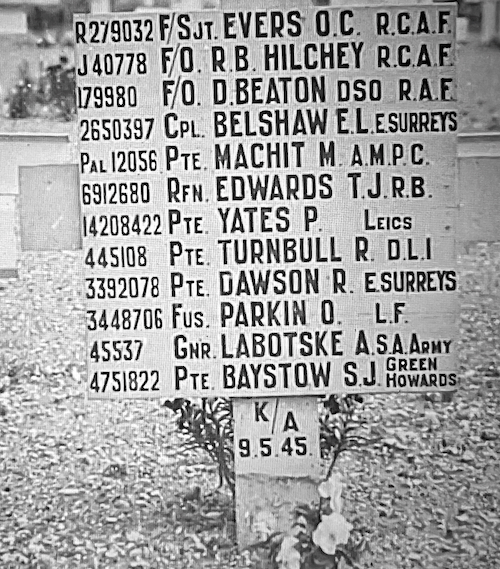
REFERENCES:
Aircrew Remembered Archive Report: RF230, F/L Beaton and Crew, by Kelvin Youngs.
Ghosts of Targets Past by Philip Gray, page 124.
LAC/ancestry.ca website.
625 Squadron ORB.
CO-AUTHORS:
Maureen Hicks
Roy Wilcock, Honorary Member of the 625 Squadron Project
Mike Edwards
Kelvin Youngs, photo editing
Submitted by Jack Albrecht and John Naylor in memory of the crew of Lancaster RF230, their passengers and with respect to the families—in particular to F/Sgt Orval Evers and his family.
RS 07.01.2023 - Reviewed and updated with new information and images
JA, JN 15.08.2023 - Addendum: Court of Inquiry and Beyond